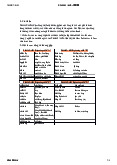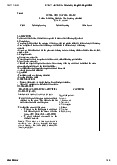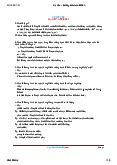






Preview text:
31 Reading the News 1 UNIT 2 Climate Change PRE-READING TASKS
1. Look at the words and check that you understand the meaning. With a partner,
group them into different categories and think of a name for each category. PLJUDWH PDWH ¿QGIRRG SUHGDWRUV PDPPDOV SUH\ birds hunt move leave have offspring caribou tundra rainfall snowfall sea ice temperature
2. Do you know 5 types of animals and their typical features? What are the reasons for
animals to migrate? Share your understanding with your friend. READING FOCUS
Focus on the newspaper: 5(&2*1,=,1*3$77(516
,WLVHDVLHUWRXQGHUVWDQGDQDUWLFOHLI\RXQRWLFHWKHSDWWHUQVLQWKHWH[W7KHZULWHURIWHQ
uses linking words or discourse markers to show the connection between what has al
ready been said and what is going to be discussed.
1. Scan the text and highlight or underline the following words +RZHYHU 7\SLFDOO\ Lastly Overall %XW
2. Match the words above with the following uses of discourse markers or linking words.
D HPSKDVL]HVWKHFRQWUDVW BBBBBBBBBBBBBBBB
E JLYHVDFRXQWHUDUJXPHQWWRDSUHYLRXVSRLQW BBBBBBBBBBBBBBBB
F LQWURGXFHVDGGLWLRQDOLQIRUPDWLRQ BBBBBBBBBBBBBBBB
G LQWURGXFHVWKHODVWDUJXPHQW BBBBBBBBBBBBBBBB
H VXPVXSWKHLQIRUPDWLRQ BBBBBBBBBBBBBBBB 32 Reading the News 1
Arctic Animals’ Movement Patterns are Shifting In Different Ways as the Climate Changes %\6R¿H%DWHV November 30, 2020 1
)RU DQLPDOV LQ WKH $UFWLF OLIH LV a 4
7KH WHDP IRFXVHG RQ WKUHH H[DPSOHV
balancing act. Seasonal cues, such as
D ORQJWHUP VWXG\ RI HDJOH PLJUDWLRQV D
warmer spring temperatures or cooler
massive study on caribou populations, and
temperatures in the fall, tell animals when
D PXOWLVSHFLHV VWXG\ IRFXVLQJ RQ VHYHUDO
to migrate, when to mate, and when and predator and prey species.
ZKHUH WR ¿QG IRRG 3UHGDWRUV DQG SUH\
birds and mammals alike follow this 5
,Q WKH HDJOH VWXG\ WKH UHVHDUFKHUV
QDWXUDOVFKHGXOHDQGDQRYHUDOOVKLIWRIMXVW
DQDO\]HG ZKHQ HDJOHV OHIW WKHLU ZLQWHULQJ
a few days or weeks could have unknown
JURXQGVWRÀ\QRUWKIRUWKHVXPPHUEDVHG
impacts on these animals and ecosystems.
RQ 1DWLRQDO 2FHDQLF DQG $WPRVSKHULF
$GPLQLVWUDWLRQ 12$$ GDWD FROOHFWHG 2
7KHVH FKDQJHV LQ VHDVRQDO WLPLQJ
IURPWR2QDYHUDJHPLJUDWLRQ
are already starting – although the shifts
started about half a day earlier each year
differ between species and populations –
± D FKDQJH WKDW FRPSRXQGHG RYHU
according to a new study published Nov.
years to cause a shift of nearly two weeks.
LQ Science that was funded in part by
³%DVLFDOO\FOLPDWHFKDQJHLVUXVKLQJWKHP
WKH 1$6$ $UFWLF%RUHDO 9XOQHUDELOLW\
WR JR QRUWK HDUO\´ VDLG %RKUHU 7KH VKLIW
([SHULPHQW $%R9( 7KH UHVHDUFKHUV
was more pronounced for adult eagles than
DQDO\]HG GDWD IURP WKH $UFWLF $QLPDO
MXYHQLOHVVXJJHVWLQJWKDWWKHMXYHQLOHVPD\
0RYHPHQW$UFKLYH$$0$DFROOHFWLRQ
be missing out on the mating season or the
RI GDWD IURP PRUH WKDQ UHVHDUFK
adults may be reaching their summering
studies tracking nearly a hundred species
grounds before their food sources.
IURPWRSUHVHQWLQFRPELQDWLRQZLWK
1$6$WHPSHUDWXUHUDLQIDOOVQRZIDOODQG 6
However, the researchers don’t know
WRSRJUDSKLF GDWD 7KH\ IRXQG WKDW $UFWLF
ZKHWKHUWKHVHFKDQJHVZLOOEHQH¿WRUKDUP
animals’ movement patterns are shifting in
different animal species, populations, or
different ways, which could disrupt entire
individuals. For example, in the caribou ecosystems.
study, it appeared that certain caribou
populations were adapting to the changes 3
³7KH$UFWLF LV VKRZLQJ PRUH H[WUHPH
LQ WKHLU VXUURXQGLQJV %RKUHU VD\V WKDW
LQGLFDWLRQV RI FOLPDWH FKDQJH´ VDLG *LO
we’ll likely see some species, individuals,
%RKUHU D SURIHVVRU DQG HQYLURQPHQWDO
DQG SRSXODWLRQV EHQH¿WWLQJ IURP FOLPDWH
engineer at Ohio State University in
change and others harmed by climate
&ROXPEXV6HDLFHLVVKULQNLQJUDLQIDOODQG
FKDQJH³%XWWKDWIDFWWKDWZHVHHFKDQJHV
VQRZIDOODUHFKDQJLQJDQG$UFWLFWXQGUDLV
is showing that something big is going on,”
turning green in some places and brown in H[SODLQHG%RKUHU
RWKHUV ³$UFWLF DQLPDOV DUH UHVSRQGLQJ WR
these changes, they’re responding quickly, 7
7\SLFDOO\ FDULERX PDWH LQ WKH IDOO
DQGWKDWUHVSRQVHLVQRWHTXDO´VDLG%RKUHU
are pregnant in the winter, and raise their 33 Reading the News 1
young in the spring when food is abundant;
by higher temperatures and increased
this schedule is tightly coordinated with
SUHFLSLWDWLRQ7KHGDWDIRUWHPSHUDWXUHDQG
HQYLURQPHQWDOSDWWHUQV7KHWHDPDQDO\]HG
precipitation in the form of rain and snow
¿YH FDULERX SRSXODWLRQV DQG IRXQG WKDW
FDPHIURP1$6$¶V'DLO\6XUIDFH:HDWKHU
SRSXODWLRQVOLYLQJLQWKHQRUWKHUQ$UFWLF±
DQG&OLPDWRORJLFDO6XPPDULHVRU'D\PHW
where things are shifting more rapidly due
to climate change – were having offspring 9
7KH WUHQGV LQ PRYHPHQW IRU GLIIHUHQW
earlier to coincide with the changes in
VSHFLHVYDULHGZLGHO\VRPHVSHFLHVPRYH
their environment, suggesting that these
more when summer temperatures are higher
populations are adapting to climate
while others move less, moose and wolves
change. However, the southern caribou
move less in winters with higher snowfalls,
populations that are experiencing less
and increased summer rain didn’t seem to
rapid environmental changes had offspring
change movement patterns for any species.
DW WKHLU XVXDO WLPH 7KH WLPLQJ RI KDYLQJ
%XW RYHUDOO SUHGDWRU VSHFLHV VHHPHG
offspring was also affected by the elevation
to respond to climate change differently
of the population’s home range(OHYDWLRQ
WKDQSUH\VSHFLHV7KDWFDXVHVDPLVPDWFK
LQIRUPDWLRQ FDPH IURP $UFWLF'(0 D
between predators and the prey they hunt
SXEOLFSULYDWHSDUWQHUVKLSWRFUHDWH GLJLWDO
IRUIRRG7RGHWHUPLQHWKHLPSDFWVRIWKLV
elevation models that is funded in part by
mismatch, researchers will need to continue 1$6$ monitoring these populations. 8
Lastly, the researchers used data from 10
“More and more, the ecosystem that
VHYHUDO VWXGLHV LQ WKH $$0$ GDWDEDVH
should be tightly coordinated is getting out
WR ¿JXUH RXW KRZ YDULRXV SUHGDWRU DQG
of whack´VDLG%RKUHU
SUH\ VSHFLHV ± EODFN EHDUV JUL]]O\ EHDUV
caribou, moose and wolves – are affected 34 Reading the News 1 UNDERSTANDING THE ARTICLE
Choose the best answer A, B or C for the following questions.
7KHUHVHDUFKHUVIRXQGWKDW$UFWLFDQLPDOV¶PRYHPHQWSDWWHUQVDUHVKLIWLQJLQGLIIHUHQW ZD\VFRXOG
$GLVUXSWWKHHFRV\VWHP %EHQH¿WWKHP &KDUPWKHP
7KHVWXG\GDWDVKRZHGWKDWFOLPDWHFKDQJHFRXOGPDNHHDJOHVWR
$GHOD\WKHLUPLJUDWLRQ
%OHQJWKHQWKHLUPLJUDWLRQ
&VWDUWWKHLUPLJUDWLRQHDUOLHU
7KHVWXG\RIFDULERXSRSXODWLRQVUHYHDOHGWKDWGXHWRFOLPDWHFKDQJHFDULERXWHQGWR
$VKLIWWKLQJVIDVWHUWRPDWFKZLWKFOLPDWHSDWWHUQV
%OLYHLQWKHQRUWKHUQ$UFWLF
&PRYHWRWKHVRXWKHUQ$UFWLFWRH[SHULHQFHOHVVFOLPDWHFKDQJH VOCABULARY WORK
1. Focus on prepositions0DWFKWKHSKUDVHVLQWKH¿UVWFROXPQZLWKWKHZRUGVRUSKUDVHV
LQWKHVHFRQGFROXPQ6HOHFWWKHFRUUHFWFRQQHFWLQJSUHSRVLWLRQVIURPWKHER[EHORZ$OO
expressions can be found in the article. One of them has been done for you EHWZHHQ ZLWK IURP WR RQ E\
WKHVKLIWVGLIIHU BBBBBBBBBBBBBB a. climate change
$UFWLFDQLPDOVDUHUHVSRQGLQJ BBBBBBBBBBBBBB b. the changes
7KHWHDPIRFXVHG BBBBBBRQBBBBBB c. higher temperatures DIIHFWHG
BBBBBBBBBBBBBBB d. predators and the prey EHQH¿WWLQJ
BBBBBBBBBBBBBBB e. species and populations FRRUGLQDWHG
BBBBBBBBBBBBBBB f. three examples FRLQFLGH
BBBBBBBBBBBBBBB g. these changes 8. a mismatch
BBBBBBBBBBBBBBB h. environmental patterns
2. Make sentences.&UHDWH\RXURZQVHQWHQFHVZLWKVRPHRIWKHH[SUHVVLRQVLQ([HUFLVH 35 Reading the News 1 EXAM PREPARATION TASKS
1. Words and phrases explanation
Explain the following words and expressions, as used in the article. a. more pronounced
…………………………………………………………………………………………… b. missing out
…………………………………………………………………………………………… c. home range
…………………………………………………………………………………………… d. funded in part
…………………………………………………………………………………………… e. getting out of whack
…………………………………………………………………………………………… 2. Comprehension questions
Read the article and answer the following questions.
D:KDWGLGWKHGDWDRIWKHVWXG\SXEOLVKHGRQ1RYLQScienceVKRZDERXW$UFWLFDQL mals’ movement patterns?
……………………………………………………………………………………………
……………………………………………………………………………………………
E+RZDUHWKH$UFWLFDQLPDOVUHVSRQGLQJWRFOLPDWHFKDQJH"
……………………………………………………………………………………………
……………………………………………………………………………………………
F+RZGLIIHUHQWO\GRWKHQRUWKHUQDQGVRXWKHUQ$UFWLFFDULERXUHVSRQGWRFOLPDWHFKDQJH"
……………………………………………………………………………………………
……………………………………………………………………………………………
d. What causes mismatch between predators and the prey?
……………………………………………………………………………………………
…………………………………………………………………………………………… DISCUSSION PROMPTS
:KDWDUHVRPHFDXVHVRIFOLPDWHFKDQJH"
+RZGRHVLWDIIHFWKXPDQEHLQJVDQGDQLPDOV"
:KDWDUHVRPHVROXWLRQVIRUFOLPDWHFKDQJHDQGKRZFDQZHDGDSWWRLW"
6KRXOGKXPDQEHLQJVEHUHVSRQVLEOHIRUFOLPDWHFKDQJH" 36 Reading the News 1 EXTRA READING
Global-scale Animal Ecology Reveals Behavioral
Changes in Response to Climate Change
By Maryland University November 5, 2020 1
8VLQJDQHZODUJHVFDOHGDWDDUFKLYHRI
DERXW WKH UHVSRQVH RI (DUWK¶V V\VWHPV WR
animal movement studies, an international
FOLPDWH FKDQJH DQG KXPDQ DFWLYLW\ %XW
team including University of Maryland
ELJSLFWXUHWUHQGVLQDQLPDOEHKDYLRUKDYH
biologists found that animals are responding
EHHQ GLI¿FXOW WR VWXG\ LQ SDUW EHFDXVH
in unexpected ways to climate change.
animal ecology is not traditionally studied
7KH DUFKLYH FRQWDLQV GDWD IURP VWXGLHV
across landscapes that span entire regions
DFURVV WKH JOREDO $UFWLF DQG VXE$UFWLF
of the globe, and also because the necessary
an enormous region that is experiencing
data are collected by a variety of agencies
some of the most dramatic effects of global
DQGMXULVGLFWLRQV DQG DUHWKHUHIRUH QHLWKHU
warming, including animal declines.
VWDQGDUGL]HGQRUHDVLO\DFFHVVLEOH 2
$IWHU GHYHORSLQJ WKH DUFKLYH WKH 5
7R DGGUHVV WKHVH LVVXHV *XUDULH DQG
researchers used it to conduct three case
his collaborators spent years building
studies that revealed surprising patterns
relationships with scientists from national,
and associations between climate change
regional and First Nations governments
and the behavior of golden eagles, bears,
and research groups throughout the
FDULERX PRRVH DQG ZROYHV 7KLV ZRUN
$UFWLF WR FRQYH\ WKH EHQH¿WV RI VKDULQJ
demonstrates both the feasibility and
data in a global repository that they call
importance of studying animal ecology on
WKH $UFWLF $QLPDO 0RYHPHQW $UFKLYH
H[WUHPHO\ ODUJH VFDOHV $ UHVHDUFK SDSHU
$$0$ &XUUHQWO\ WKH DUFKLYH LQFOXGHV
describing the archive and case studies
contributions from researchers from over
DSSHDUVLQWKH1RYHPEHULVVXHRI
XQLYHUVLWLHVJRYHUQPHQWDJHQFLHVDQG
WKHMRXUQDOScience.
FRQVHUYDWLRQJURXSVDFURVVFRXQWULHV 3
³,¶PUHDOO\H[FLWHGDERXWKRZWKLVZRUN 6
7KH DUFKLYH LQFOXGHV GDWD IURP
shows what you can learn from comparing
terrestrial and marine animal tracking
data across populations on a very large
studies representing more than 8,000
VFDOH´ VDLG (OLH *XUDULH DQ DVVRFLDWH
DQLPDOV EHWZHHQ DQG WKH SUHVHQW
research scientist in UMD’s Department
8VLQJ WKLV GDWD *XUDULH DQG PHPEHUV RI
RI%LRORJ\DQGDFRDXWKRURIWKHSDSHU³,
KLV ODE DQDO\]HG WKH PRYHPHQWV RI PRUH
would say this is an early example of what
WKDQ IHPDOH FDULERX IURP WR
we might call global animal movement
7KH\ IRXQG WKDW WKH LFRQLF ORQJ
ecology. We’re increasing our ability to
distance migrating caribou are giving birth
monitor the pulse of animal populations
earlier in the spring, roughly tracking rates
DFURVV WKH (DUWK DQG DVN ELJ SLFWXUH
RIZDUPLQJ%XWDPRQJWKHQRQPLJUDWRU\
questions about what it means.”
mountain and lowland woodland caribou
RQO\ WKH QRUWKHUQ VXESRSXODWLRQV DUH 4
/DUJHVFDOH PRQLWRULQJ RI WKLQJV OLNH
showing similar changes. While the drivers
VHDVXUIDFH WHPSHUDWXUH DQG JOREDO IRUHVW
of these differences remain a mystery,
cover have revealed important information
understanding their behavior is critical 37 Reading the News 1
to anticipating how they will respond as
seen through decades of movement data
WKH $UFWLF FRQWLQXHV WR ZDUP DQG PDQ\
and may have implications for breeding
populations continue to decline. success. 7
³,W¶VWULFN\WRSUHGLFWKRZWKHVHWUHQGV
10 $ WKLUG VWXG\ E\ 3HWHU 0DKRQH\ RI
PLJKW LPSDFW SRSXODWLRQV´ *XUDULH VDLG
the University of Washington looked at
“On the one hand, it can be better to give
the movement speeds of bears, caribou,
birth earlier, as it gives the calves more
PRRVH DQG ZROYHV IURP WR
opportunity to grow during the summer
His study showed that species respond
season. On the other hand, giving birth
differently to seasonal temperatures and
too early may mean you literally don’t
ZLQWHUVQRZFRQGLWLRQV7KRVHGLIIHUHQFHV
have time to reach the optimal calving
FRXOG LQÀXHQFH VSHFLHV LQWHUDFWLRQV IRRG
JURXQGV 7KH DELOLW\ WR ORRN DW ELRORJLFDO
FRPSHWLWLRQDQGSUHGDWRUSUH\G\QDPLFV
processes, like birth, at such a large scale,
across populations and subspecies and
11 7KH VFLHQWLVWV H[SHFW WKDW RWKHU
over millions of square kilometers, is
UHVHDUFKHUVZLOOFRQWLQXHWRPLQHWKH$$0$
unprecedented for a species in such a remote
for answers to pressing questions about
DQGKDUVKHQYLURQPHQW7KHVHUHVXOWVUHYHDO
whether and how animals are responding to
patterns that we would not have suspected,
DFKDQJLQJ$UFWLF0HDQZKLOHWKHUHVRXUFH
and point to further lines of inquiry about
continues to expand as more data comes in
everything from caribou evolution to their
from currently tracked animals and more
ability to adapt to environmental changes researchers add their studies. moving forward.”
12 ³7KLV ZRUN KDV JLYHQ XV D EDVHOLQH 8
'DWD DQDO\VLV WRROV *XUDULH GHYHORSHG
WR XQGHUVWDQG WKH ODUJHVFDOH SLFWXUH VR
to study caribou were also used for another
we can get a sense of how animals and
case study led by his collaborators.
environments are really interacting across
species and across space as the environment 9
,Q DQ DQDO\VLV FRPSDULQJ PRYHPHQWV
FKDQJHV´*XUDULHVDLG
RI PRUH WKDQ JROGHQ HDJOHV IURP
WR 6FRWW /D3RLQW D UHVHDUFKHU
* Materials provided by University of
IURP &ROXPELD 8QLYHUVLW\ ZKR LV QRZ DW
Maryland. Content may be edited for style
%ODFN5RFN)RUHVW&RQVRUWLXPIRXQGWKDW and length.
immature birds migrating north in the spring
arrived earlier following mild winters,
Journal Reference:
ZKLOH DGXOW ELUGV GLG QRW 7KH WLPLQJ
Sarah C. Davidson et al. Ecological
shift for young birds varied in response
WR D ODUJHVFDOH FOLPDWH F\FOH FDOOHG WKH
insights from three decades of animal
movement tracking across a changing
3DFL¿F'HFDGDO2VFLOODWLRQZKLFKLVEHLQJ
Arctic. Science, 2020 DOI: 10.1126/
DIIHFWHG E\ FOLPDWH FKDQJH 6XFK DJH
related behavior changes could only be science.abb7080 Extra Reading Tasks
5HDGWKHWH[WDQGQRWHGRZQVRPHNH\LQIRUPDWLRQDERXWWKHDUWLFOH
6KDUH\RXUXQGHUVWDQGLQJVDERXWWKHDUWLFOHZLWK\RXUIULHQGV




